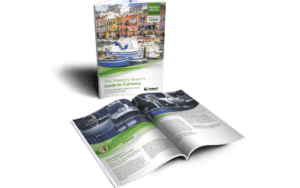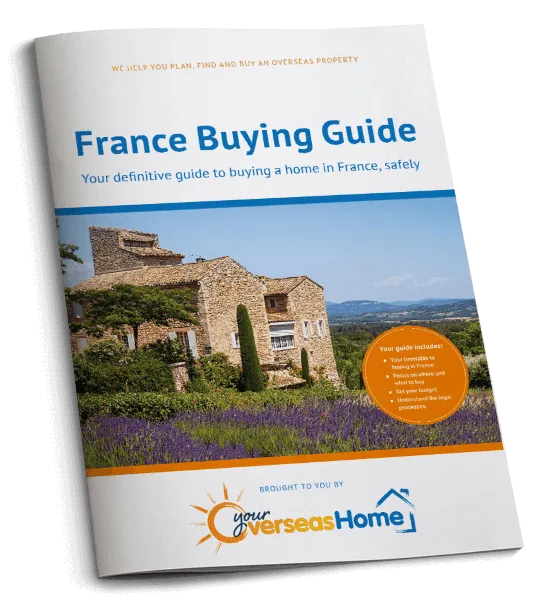There are big advantages to buying property on France’s north-eastern coast, and not just in the savings in traveling time. The ‘Opal’ and ‘Alabaster’ coasts are beautiful and verdant, with small towns bursting with lively markets, delicious cuisine and affordable homes.
France’s north-eastern coast is the first sight that many Brits have of France every year. For some, that initial excitement (“we’re here!”) of seeing French street signs and tuning in to a French radio station, plus the stress of remembering to drive on the right, means we speed off to the south-west or Paris without really taking in what a nice place this would be to buy a property.
Find homes in France via our property portal.
The section of coast from Belgium down to Le Havre comprises around 300 kilometres of attractive and exciting coastline, with two ‘parc naturel’ just inland and several lovely local communities.
Of course, in terms of weather and geography it’s not so different to the English side of La Manche, but if you’ve ever taken the Newhaven to Dieppe ferry, let’s just say we know which side we’d rather live in!
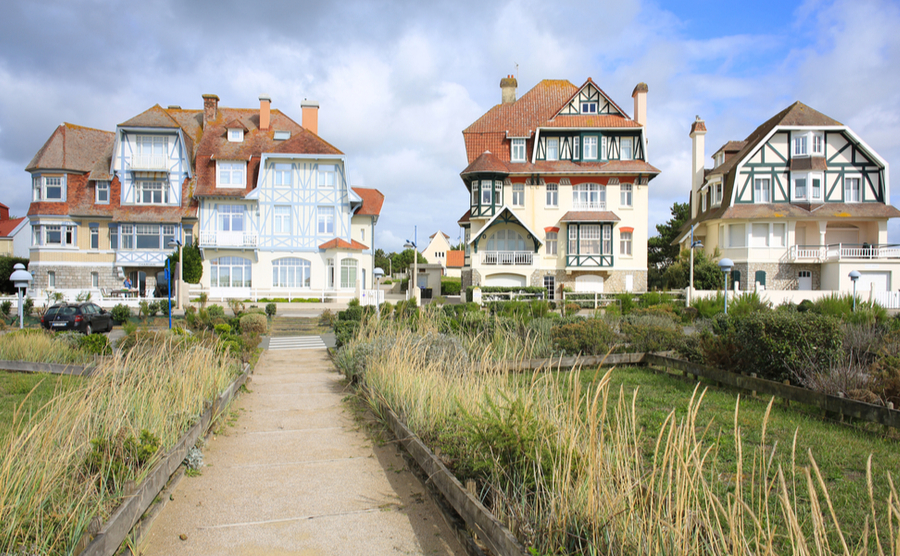
Houses in the spa town of Hardelot-Plage, Côte d’Opale (Traveller70 / Shutterstock.com)
The coasts
The top end of the coast, from Bray-Dunes near Dunkirk down to the nicer-than-it-sounds Berck-Sur-Mer is 120 kilometres of sandy beaches and charming villages named the Opal Coast (Côte d’Opale).
Beyond Berck is the Baie de Somme, a wildlife refuge where several rivers meet the sea. And from Le Tréport down to Le Havre is another 120 kilometres or so of the Côte d’Albâtre (“Alabaster Coast”, although let’s be honest, it sounds better in French) which gets its name from the chalk cliffs.
The British, of course, have a long association with these areas – not least from various wars, the place names redolent of our shared history from Dunkirk to Dieppe, through the Somme battlefields to Agincourt and earlier.
But buying a holiday property on the north-eastern coast of France you won’t just be competing with other Brits – it’s also a favourite area for Parisians and those from cities like Rouen and Amiens too.
Inland property on France’s north-eastern coast
There are some beautiful areas inland from the cliffs, beaches and channel ports.
It includes rich, bocage-like farmland, but also some wilder areas and even wolves are now known to stray this far north. In the north Caps et Marais d’Opale natural park stretches inland for 70 kilometres from Boulogne and Calais to Saint Omer. The park offers great opportunities for healthy lifestyle, with hiking, riding and cycling. There are several villages in and around the park, making up a population of some 200,000.
At the other end, from Honfleur to Rouen, is the Boucles de la Seine (“Meanders of the Seine”) natural park. There are numerous trails through the orchards and cattle farms of the park, and even some of the white horses have been brought up from the Camargue to graze and generally look wild and beautiful.
Again, there are numerous villages to look for a property, all within easy reach of the Channel ports, so you can reach your home – even by bicycle – within an hour or two of disembarking from the ferry. There is also a good train service connecting the villages.
Buying property on the Côte d’Opale
For international buyers seeking a home in an idyllic coastal setting, the Opal Coast offers quaint fishing villages, exciting resort towns and romantic windswept headlands.
The channel ports of Northern France – Dunkirk, Calais and Boulogne – lead to many places of interest inland and on the coast: Arras, Amiens, Beauvais, Abbeville, Le Touquet and more.
Although separated by only 50 miles and a Channel crossing, property buyers on France’s north-eastern coast will find that property prices are a third to half the price of the equivalent in England.
However, culturally and gastronomically you will feel a long way from home. It is an appealing thought for those who want to keep in close touch with family.
Here are a few suggestions:
Le Touquet-Paris-Plage
The “Pearl of the Opal Coast,” Le Touquet has been captivating visitors for over a century with its beaches and dunes backed by lush pine forests. It’s long-been popular with the British, with the likes of Noel Coward and P.G. Wodehouse escaping here to write. The town has elegant architecture, and while it’s not as glamorous as it was once, it’s colourful, full of flowers, thatched villas and great shops and restaurants.
Boulogne-sur-Mer
Boulogne-sur-Mer is the largest fishing port in France, but don’t let that put you off. It has a medieval old town, with charming cobblestone streets and, as you might expect, an excellent fish market. Boulogne-sur-Mer’s proximity to the Channel Tunnel and ferry ports makes it a convenient choice for international buyers seeking easy access to the UK and mainland Europe.
Seaside villages
There is a string of villages along the coast. For the appeal of Wissant, the clue is in the name, a corruption of the Dutch name for white sand. Wissant has a beach with mile after mile of it. Outside of summer it’s a quiet village of around 1,000 people between Calais and Boulogne. Wissant is between the famous landmarks Cap Blanc-Nez, a cliff of 134 metres, and Cap Gris-Nez, the closest point of France to England.
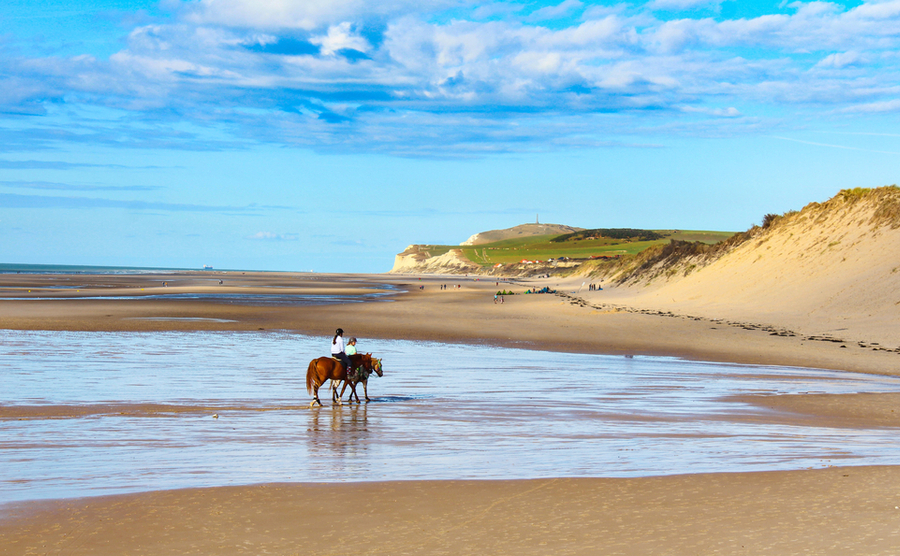
The beach at Wissant, looking towards Cap Blanc-Nez
Buying property on the Côte d’Albâtre
The cliffs which gave the name to the coast are essentially the same range of hills as on Sussex’s South Downs, which are the last sight you see from the ferry taking you to Dieppe and a new life in France .
This stretch of coast is around 120 kilometres long, from Le Havre in the south to Le Tréport in the north. It features highlights such as Dieppe and Étretat. Here are a few suggestions for property buyers.
Étretat
Swimming at this lovely little town can be something really special, with the great arched cliffs to the west and needle-like formations. Moreover, the local authorities, unlike many UK resorts, make the best pf it, with platforms set off the beach to swim to and no shortage of lifeguards making for a safer experience for families.
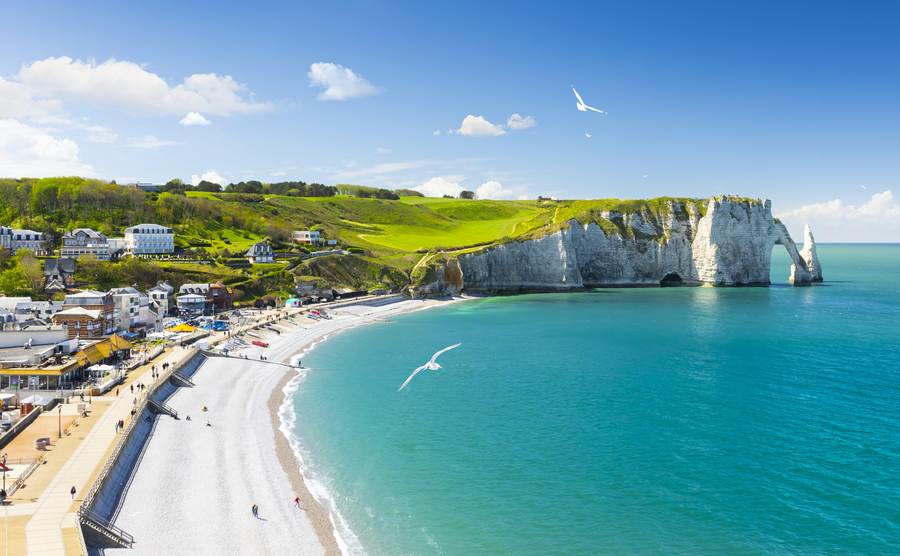
Etretat
Étretat has captivated artists and writers for centuries, and not just for the landscape. It has a lively town centre with excellent restaurants and cafes.
Fécamp
Another historic fishing village, nestling in a sheltered bay, Fécamp is most famous for its Benedictine Palace where monks created the liqueur Benedictine. You can drink it in the many waterfront cafes.
Saint-Valery-en-Caux
At the mouth of the Veules River, Saint-Valery-en-Caux has a population of around 4,000. It is set around a picturesque harbour serving the catch of the day, perfect for people watching in summer. There is history too, with a medieval quarter and the ruins of an 11th-century castle.
Veules-les-Roses
A pleasant walk along the coast, Veules-les-Roses is a fraction of the size of Saint-Valery but is extremely pretty, with several watermills and thatched cottages. Indeed it is widely regarded as one of the most beautiful villages in Normandy.
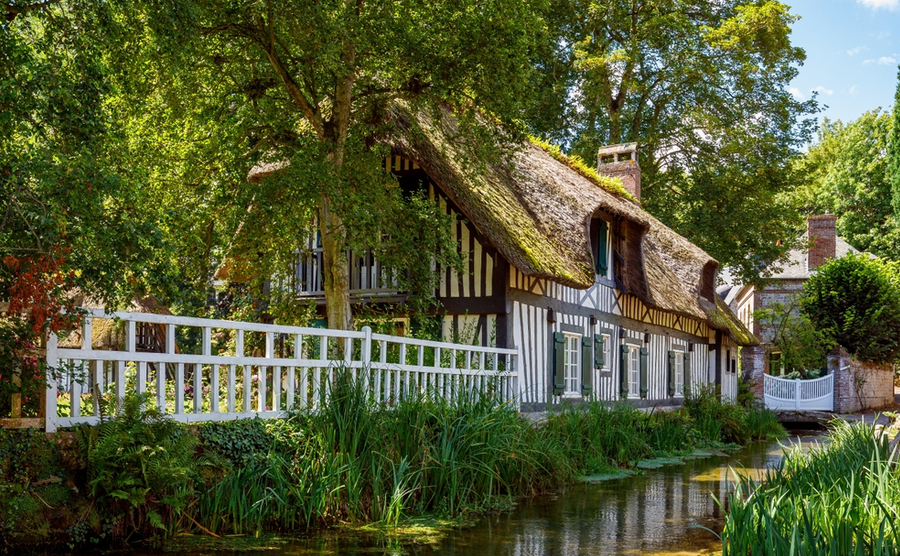
Veules les Roses
Dieppe
As one of the major ports on the Alabaster Coast, Dieppe has a rich maritime history and long association with both the British and Canadians, who fought and famous battle here in the Second World war. Sadly, the ferry no longer stops in the centre of town, disgorging passengers straight onto the train to Paris, but the port area is beautiful and there is always something going on along the long promenade and beach.
The old town has excellent shops, but also attractive narrow streets and historic buildings, with an excellent Saturday market.


